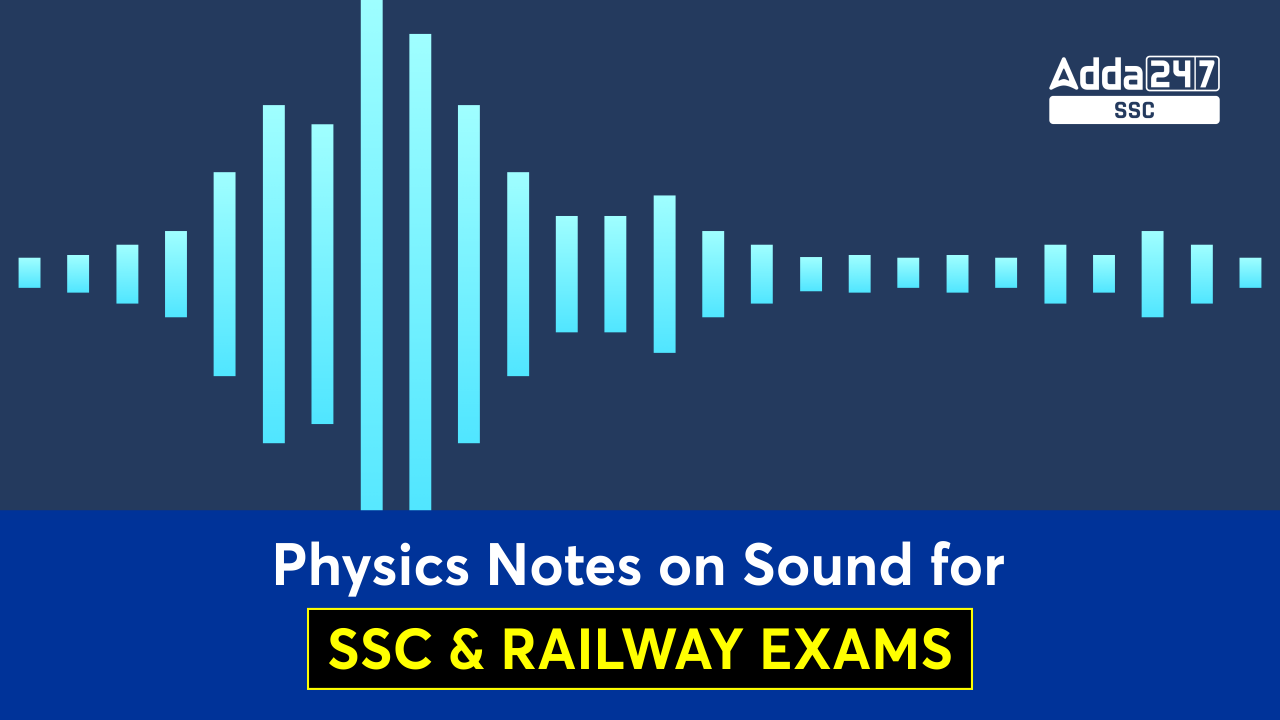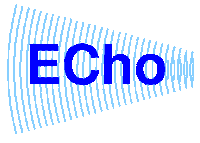SOUND
Definition of Sound: Sound is a form of energy which is transmitted in the form of waves.
The speed of sound in a medium depends:
- The temperature of the medium.
- The pressure of the medium.
- The speed of sound decreases when we go from solid to a gaseous state.
- In any medium, as we increase the temperature the speed of sound increases.
- The velocity of sound through a gas is inversely proportional to the square root of the density of the gas.
- Sound is mechanical energy that produces a sensation of hearing. Sound is produced due to the vibration of different objects.
- The sound wave propagates as compressions & rarefactions in the medium. Sound waves are longitudinal waves.
Production of Sound: Sound is produced by vibrating objects. Vibration means a kind of rapid-to-and-fro motion of an object. The sound of the human voice is produced due to vibrations in the vocal cords.
Propagation of Sound: The matter or substance through which sound is transmitted is called a medium. It can be solid, liquid, or gas. Sound moves through a medium from the point of generation to the listener. Sound waves are produced due to variations in the pressure & density of the medium.
TYPES OF WAVES
On the basis of the direction of propagation, waves can be divided into 2 types:
Longitudinal Waves: In these waves, the individual particles of the medium move in a direction parallel to the direction of propagation of the disturbance. The particles do not move from one place to another but they simply oscillate back and forth about their position of rest. E.g. Sound waves.
Transverse Waves: In these waves, particles do not oscillate along the line of wave propagation but oscillate up and down about their mean position as the wave travels. E.g. Light is a transverse wave.
Characteristics of Sound Wave And Related Terms
- Compression (C): These are regions of high pressure and density where particles are crowded together. They are represented by the peak or upper portion of the wave curve known as the crest.
- Rare-factions(R): These are the regions of low pressure and density where the particles are spread out and are represented by the lower portion of the curve called troughs or valleys.
- Amplitude: The amplitude of a sound wave refers to the magnitude of the maximum disturbance in the medium. It represents the distance from the equilibrium or mean value to the highest point of the wave. Amplitude is usually denoted by the letter A and is measured in units of density or pressure.
- Oscillation: It is the change in density (or pressure) from the maximum value to the minimum value and again to the maximum value.
- Frequency: Frequency is the number of complete oscillations (compressions or rarefactions) that occur in a sound wave per unit of time. It is typically represented by the Greek letter ν (nu) and measured in hertz (Hz). The larger the amplitude of the vibration, the louder the sound.The higher the frequency of vibration, the higher the pitch, and the shriller the sound.
- Time Period: Time period is the time taken by two consecutive compressions or rarefactions to cross a fixed point. It is denoted by the symbol T and measured in seconds (s). The time period is the reciprocal of the frequency. It can calculated as : Time Period = 1/ Frequency.
- Wavelength: Wavelength is the distance between two consecutive compressions or two consecutive rarefactions in a sound wave. It is represented by the Greek letter λ (lambda) and measured in meters (m).
- The speed of sound: The speed of sound is the distance traveled by a point on a wave (such as a compression or rarefaction) per unit of time. It can be calculated by multiplying the wavelength of the wave by its frequency.
Example: A sound wave has a frequency of 2 kHz and wavelength of 35 cm. How long will it take to travel 1.5 km?
Frequency, ν = 2 kHz = 2000 Hz
Wavelength, λ = 35 cm = 0.35 m
Speed of the wave = wavelength × frequency
v = λ ν = 0.35 m × 2000 Hz = 700 m/s
The time taken by the wave to travel a distance, d of 1.5 km is
1500/700 = 2.1 s
Thus, the sound will take 2.1 s to travel a distance of 1.5 km.
Range of Hearing of Sound: The audible range of sound for human beings extends from about 20 Hz to 20000 Hz (one Hz = one cycle/s).
- Sounds of frequencies below 20 Hz are called infrasonic or infrasound sounds. Rhinoceroses communicate using infrasound of frequency as low as 5 Hz. Whales and elephants produce sound in the infrasound range.
- Frequencies higher than 20 kHz are called ultrasonic sound or ultrasound. Ultrasound is produced by dolphins, bats, and porpoises.
ULTRASOUND
Applications
- Ultrasounds can be used to detect cracks and flaws in metal blocks. Metallic components are generally used in the construction of big structures like buildings, bridges, machines, and also scientific equipment.
- Ultrasound is generally used to clean parts located in hard-to-reach places, for example, spiral tubes, odd-shaped parts, electronic components, etc.
- Ultrasonic waves are made to reflect from various parts of the heart and form the image of the heart. This technique is called ‘echocardiography’.
- An ultrasound scanner is an instrument that uses ultrasonic waves for getting images of the internal organs of the human body. It helps the doctor to detect abnormalities, such as stones in the gall bladder and kidney or tumors in different organs. The technique is called ‘ultrasonography’.
- Ultrasound may be employed to break small ‘stones’ formed in the kidneys into fine grains. These grains later get flushed out with urine.
SONAR
The acronym SONAR stands for Sound Navigation And Ranging. Sonar is a device that uses ultrasonic waves to measure the distance, direction, and speed of underwater objects.
- Sonar consists of a transmitter and a detector and is installed in a boat or a ship. The transmitter produces and transmits ultrasonic waves.
- These waves travel through water and after striking the object on the seabed, get reflected back and are sensed by the detector.
- The detector converts the ultrasonic waves into electrical signals which are appropriately interpreted.
- The distance of the object that reflected the sound wave can be calculated by knowing the speed of sound in water and the time interval between transmission and reception of the ultrasound.
Let the time interval between transmission and reception of ultrasound signal be t and the speed of sound through seawater be v.
The total distance, 2d traveled by the ultrasound is then,
2d = v × t,
The above method is called echo ranging.
The sonar technique is used to determine the depth of the sea and to locate underwater hills, valleys, submarines, icebergs, sunken ships, etc.
SUPERSONIC SOUND
Again if the speed of any substance, especially of an aircraft, is more than the speed of sound in air, then the speed of the substance is called supersonic speed.
INFRASONIC SOUND
Sounds of frequencies below 20 Hz are called infrasonic sounds or infrasound.
Example:
Rhinoceroses communicate using infrasound of frequency as low as 5 Hz. Whales and elephants produce sound in the infrasound range. It is observed that some animals get disturbed before earthquakes. Earthquakes produce low-frequency infrasound before the mainshock waves begin which possibly alert the animals.
ULTRASONIC SOUND
Frequencies higher than 20 kHz are called ultrasonic sound or ultrasound.
Example:
Ultrasound is produced by dolphins, bats, and porpoises.
Applications:
- Ultrasounds can be used to detect cracks and flaws in metal blocks.
- Metallic components are generally used in the construction of big structures like buildings, bridges, machines, and also scientific equipment.
- The cracks or holes inside the metal blocks, which are invisible from the outside reduces the strength of the structure. Ultrasonic waves are allowed to pass through the metal block and detectors are used to detect the transmitted waves. If there is even a small defect, the ultrasound gets reflected back indicating the presence of the flaw or defect.
- Ultrasonic waves are made to reflect from various parts of the heart and form the image of the heart. This technique is called ‘echocardiography’.
- An ultrasound scanner is an instrument that uses ultrasonic waves for getting images of the internal organs of the human body. A doctor may image the patient’s organs such as the liver, gall bladder, uterus, kidney, etc. It helps the doctor to detect abnormalities, such as stones in the gall bladder and kidney or tumors in different organs. In this technique, the ultrasonic waves travel through the tissues of the body and get reflected from a region where there is a change in tissue density. These waves are then converted into electrical signals that are used to generate images of the organ. These images are then displayed on a monitor or printed on a film. This technique is called ‘ultrasonography’.
MACH NUMBER
The ratio of the speed of a body and that of sound in air is, however, called the Mach number of the body. If the Mach number of a body is more than 1, it is clear that the body has supersonic speed.

REFLECTION OF SOUND (ECHO )
- It is a reflection of sound that arrives at the listener with a delay after the direct sound.
- The sensation of sound persists in our brain for about 0.1 seconds.
- To hear a distinct echo, the time interval between the original sound and the reflected one must be at least 0.1 seconds.
- For hearing distinct echoes, the minimum distance of the obstacle from the source of sound must be 17.2 m. This distance will change with the temperature of the air. Echoes may be heard more than once due to successive or multiple reflections.
REVERBERATION
AUDIBLE RANGE
The audible range of sound for human beings extends from about 20 Hz to 20000 Hz (one Hz = one cycle/s). Children under the age of five and some animals, such as dogs can hear up to 25 kHz (1 kHz = 1000 Hz).




 Free Study Material for SSC CGL 2025, Do...
Free Study Material for SSC CGL 2025, Do...
 Reasoning Topics Asked in SSC CGL Exam L...
Reasoning Topics Asked in SSC CGL Exam L...
 Pandit Jawaharlal Nehru, First Prime Min...
Pandit Jawaharlal Nehru, First Prime Min...









